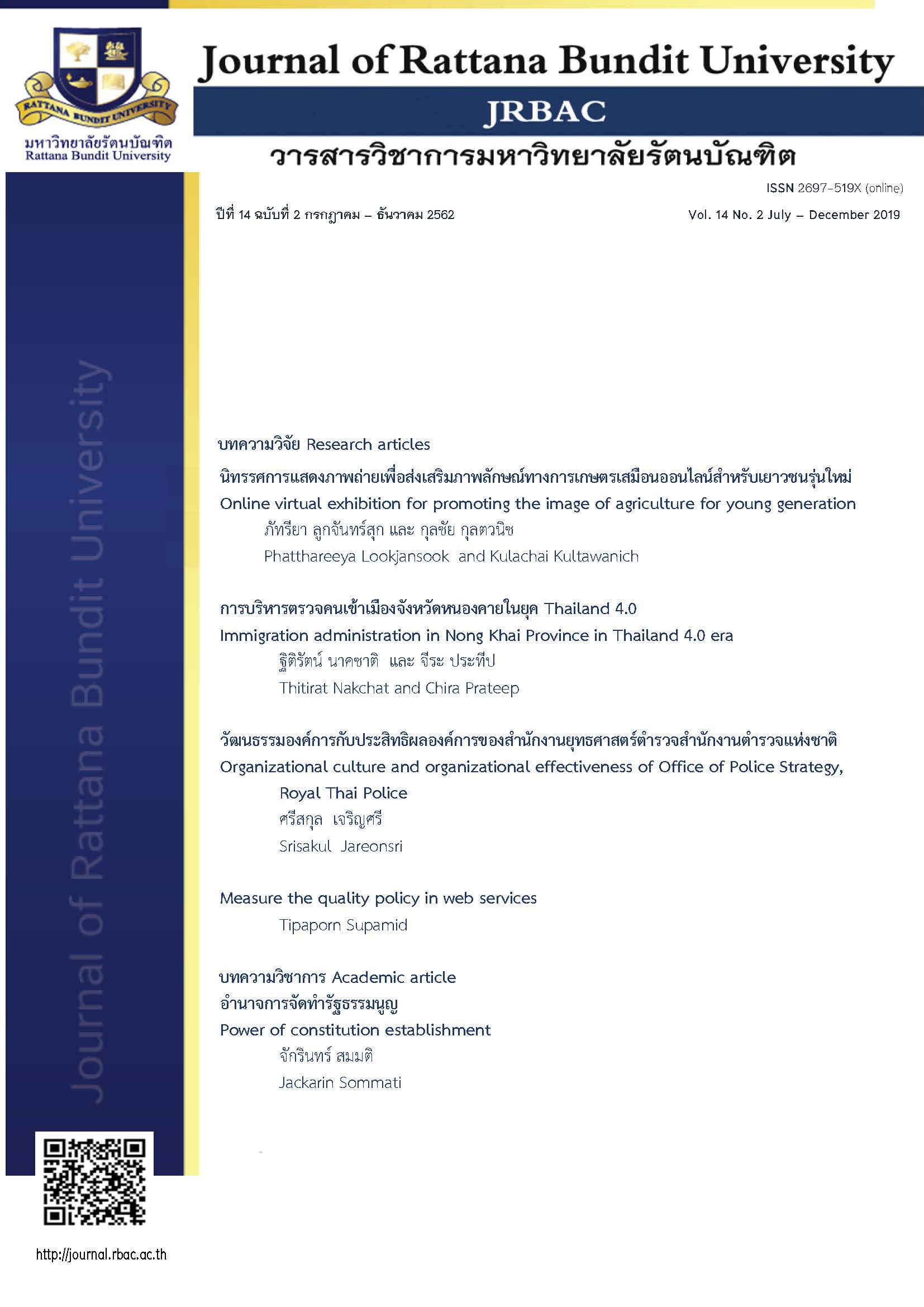Organizational culture and organizational effectiveness of the Office of Police Strategy, Royal Thai Police
Main Article Content
Abstract
This research aimed to examine relationship between organizational culture and organizational effectiveness, to determine types of organizational culture, that effect on each effectiveness model in the Office of Police Strategy, to study the problems, obstacles, and give suggestions which involve the effectiveness of Office of Police Strategy. The approach to study was quantitative methods. The sample used in this study include 200 police officials in superintendent position or lower in the Office of Police Strategy. Where were selected through stratified cluster multistage sampling. Data collection was done by using survey questionnaire. Analysis of data was done by using package program for social research, the statistical analysis methods applied to this research comprised descriptive statistics and inferential statistics, such as percentage, means, standard deviation, Pearson product-moment correlation coefficients and linear multiple regression analysis. Whereas in the open-ended questionnaire, the data was analyzed by content analysis. The results of the study showed that: Organizational culture is positively correlated with organization effectiveness of the Office of Police Strategy at statistical has a very highly significant level of 0.01 (r=0.89, p <0.01). The different types of organizational culture were also predictors of each effectiveness model in the Office of Police Strategy. Furthermore, the mission culture was the most prominent of the four types in term of fostering all organizational effectiveness models.
The suggestions for improving organization effectiveness of the Office of Police Strategy for example, Trainings should be regularly conducted to increase knowledge and competencies of
the personnel. Workplace environment should be more pleasant. Organizational cultures that focus on teamwork should be encouraged. And there should be more coordination within and between departments. Rewards and compensations should be given according to one’s ability and appropriateness of occasion.
Article Details
References
Boonchaluay, P. (2013). Watthanatham ʻongkān ʻongkān kān rīanrū kap prasitthiphon ʻongkān khō̜ng sān yuttitham: Tūa bǣp samakān khrōngsāng [Organization culture, learning organization and the organizational effectiveness of the courts of justice: Structural equation model] (Thesis Doctor of Philosophy). National Institute of Development Administration, Bangkok. (in Thai)
Chaianong, L. (2013). Thammāphibān, watthanatham ʻongkān kap prasitthiphon ʻongkān khō̜ng sān yuttitham: Tūa bǣp samakān khrōngsāng [Good governance, organizational culture and organizational effectiveness of the court of justice: Structural equation model] (Thesis Doctor of Philosophy) Faculty of Liberal Arts, Krirk University, Bangkok. (in Thai)
Chantasuwan, P. (2012). Prasitthiphon khō̜ng ʻongkān: Pati bot hǣng manō that [The effectiveness of organization: Antithesis of conceptions]. Romphruek Journal, 28, 134-182.
Cooke, A. & Szumal, L. (2000). Using organizational culture inventory to understand operating cultures of organizations. In Handbook of organizational culture and climate. N.M. Ashkanasy, C. P. M. Wilderom and M.F. Peterson. Thousand Oaks, CA: Sage.
Denison, D. R. (1990). Corporate culture and organizational effectiveness. New York: Wiley.
Denison, D. R., Haaland, S. & Goelzer, P. (2003). Corporate culture and organizational effectiveness: Is there a similar pattern around the world?. Advances in Global Leadership, 3, 205-227.
Khumphai, S. (2010). Kānprīapthīap watthanatham ʻongkān thī mī ʻitthiphon tō̜ prasitthiphonʻongkān: Kō̜ranī sưksā ratwisāhakit nai prathēt Thai [Comparison of organizational culture influencing organizational effectiveness: A case study of state enterprises in Thailand] (Thesis Doctor of Philosophy). National Institute of Development Administration, Bangkok. (in Thai)
Mongkolpithaksuk, U. (2018). Watthanatham ʻongkān kap prasitthiphon ʻongkō̜n pokkhrō̜ng sūan thō̜ngthin [Organizational culture and effectiveness of local government organizations]. Journal of Research Communities, 12(3), 66-78. (in Thai)
Phrarātchakritsadīkā bǣng sūan rātchakān Samnakngān Tamrūathǣngchāt [Royal Decree on Government Sector, Royal Thai Police 2009]. (2009, 6 September). The Government Gazette, 126, Part 65 Kor. (in Thai)
Quinn, R.E. & Rohrbaugh, J. (1983, March). A Spatial Model of effectiveness criteria: Towards a competing values approach to organizational analysis. Management Science, 29, 363-377.
Steers, Richard.M. (1977). Organizational effective: A behavioral view. California: Goodyear.
Yamane, Taro.1967. Statistics: An introductory analysis (2nd ed.). New York: Harper and Row.


